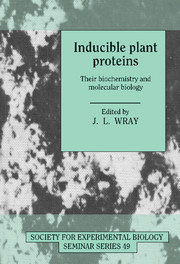Book contents
- Frontmatter
- Contents
- List of Contributors
- Preface
- Metal-binding proteins and metal-regulated gene expression in higher plants
- Phosphate starvation inducible enzymes and proteins in higher plants
- Nitrate reduction in higher plants: molecular approaches to function and regulation
- Inducibility of the glutamine synthetase gene family in Phaseolus vulgaris L.
- Expression and manipulation of genes involved in phenylpropanoid biosynthesis
- Biochemistry and molecular biology of CAM
- ABA- and GA-responsive gene expression
- Regulation of gene expression, ethylene synthesis and ripening in transgenic tomatoes
- Induction of nodulin genes and root nodule symbiosis
- Systemic acquired resistance: an inducible defence mechanism in plants
- Biochemistry and molecular biology of the anaerobic response
- The heat shock response in transgenic plants: the use of chimaeric heat shock genes
- Biochemistry and molecular biology of cold-inducible enzymes and proteins in higher plants
- GBF-1, GBF-2 and GBF-3: three Arabidopsis b-Zip proteins that interact with the light-regulated rbcS-1A promoter
- Index
Biochemistry and molecular biology of CAM
Published online by Cambridge University Press: 06 July 2010
- Frontmatter
- Contents
- List of Contributors
- Preface
- Metal-binding proteins and metal-regulated gene expression in higher plants
- Phosphate starvation inducible enzymes and proteins in higher plants
- Nitrate reduction in higher plants: molecular approaches to function and regulation
- Inducibility of the glutamine synthetase gene family in Phaseolus vulgaris L.
- Expression and manipulation of genes involved in phenylpropanoid biosynthesis
- Biochemistry and molecular biology of CAM
- ABA- and GA-responsive gene expression
- Regulation of gene expression, ethylene synthesis and ripening in transgenic tomatoes
- Induction of nodulin genes and root nodule symbiosis
- Systemic acquired resistance: an inducible defence mechanism in plants
- Biochemistry and molecular biology of the anaerobic response
- The heat shock response in transgenic plants: the use of chimaeric heat shock genes
- Biochemistry and molecular biology of cold-inducible enzymes and proteins in higher plants
- GBF-1, GBF-2 and GBF-3: three Arabidopsis b-Zip proteins that interact with the light-regulated rbcS-1A promoter
- Index
Summary
Introduction
Crassulacean Acid Metabolism (CAM) has been called a curiosity (Osmond, 1978), the importance of which has been long overlooked in the context of environmental adaptations of plants to cope with arid, hot environments. CAM has since been studied more intensely and our knowledge has been extended by focusing on physiological studies (Ting & Gibbs, 1982; Ting, 1985; Cockburn, 1985), on the biochemical characterisation of important enzymes (O'Leary, 1982; Nimmo et al., 1986), and on ecological aspects (Kluge & Ting, 1978; Lüttge, 1987).
As a result of the diurnal separation of night CO2 fixation by PEPCase, storage of the acidic product, malate, in the vacuole, and final carbon assimilation by Rubisco, CAM plants conserve water and hence can occupy ecological niches that have limited water or CO2 availability. To mention only a few examples (see Kluge & Ting, 1978), CAM is expressed in flowering plants that are continually exposed to sea water, in cacti that inhabit true deserts, in climbing vines in the rainforest (Ting et al., 1985), and in freshwater plants where CO2 is limiting (Keeley & Busch, 1984). CAM may be constitutive in a species, or the pathway may appear during ageing either throughout the plant, or specifically in the older leaves (Guralnick et al., 1984; Ting, 1985). In some plants the pathway may be induced by environmental factors, such as drought, high salinity or low temperature, which affect the availability of water (Winter, 1982).
- Type
- Chapter
- Information
- Inducible Plant ProteinsTheir Biochemistry and Molecular Biology, pp. 113 - 138Publisher: Cambridge University PressPrint publication year: 1992
- 16
- Cited by



